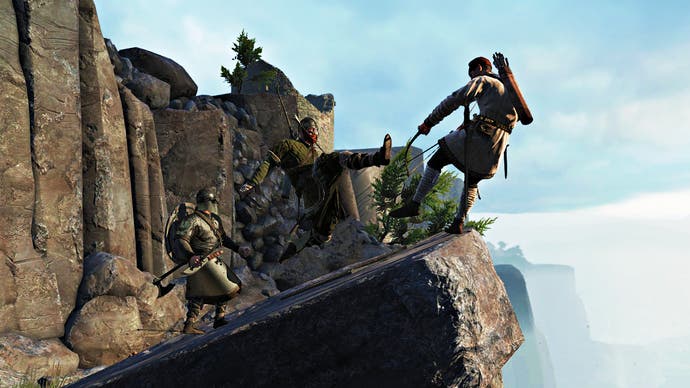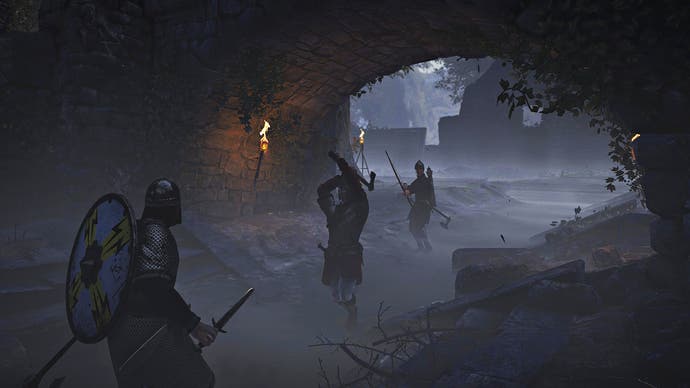How War of the Vikings respects historical fidelity, brutality and women warriors
Norse code.
The moment that I knew I wanted to be a Viking was the moment that I pushed another man off a cliff. I didn't mean to do this, but gravity and circumstance joined forces and suddenly he was gone. I suppose I didn't know my own strength. I suppose I also ignored the clues to my own strength that included: my big suit of armour, my big helmet, my big sword, my big shield.
War of the Vikings follows on from the messy melee of War of the Roses, and it will feel immediately familiar to veterans of that conflict. Its third-person combat is directed by nudges of the mouse that determine the direction of swings or parries, with timing the difference between life and death, but executive producer Gordon Van Dyke insists that a great many improvements have been made behind the scenes: "There's some similarities, obviously, but it's not just a re-skin of War of the Roses."
Most apparent is the sense of momentum that combat now has. While many of the weapons in War of the Roses certainly felt powerful and heavy, even a strong blow or a ringing shield bash would do little to shift an opponent. Now, a thrust or a charge carries weight and clashing warriors can force each other back or cause far more serious injuries as they land their strikes. This can work both ways, too, and my most grievous injury came as a result of my running right into an enemy's thrust. I did an excellent job of skewering myself in a manner that felt entirely deserved.
As well as tweaked combat mechanics, the same Bitsquid engine that powered War of the Roses has been given an update. Behind the scenes, a new anti-cheat system is being deployed, while improved visual effects present a grimmer, grimier world. Combat is also a little messier this time around, though Van Dyke says the intention isn't to be over-dramatic.
"It is a bit more gory," he explains. "We wanted to reflect that time period and the combat would've been more gruesome, but it's not going to be like some of our competitors where it goes over the top. Pointless gore isn't going to make our game better." Nevertheless, he adds, the intention was to make a game that was rougher, meaner and faster experience, a game where bodies fall faster and fall harder. There's no need to execute any of War of the Roses' clinical finishing moves and there's fewer of that game's lengthy, measured duels.
"I picked this time period because I wanted a more aggressive game," Van Dyke says. "The technology and the way fights unfolded in the War of the Roses area meant they lasted longer and they were more about precision. Often you didn't actually kill your opponent, it was more about disabling them. During the Viking age, that wasn't an option. A Viking wanted to die in battle, to go to Valhalla. They'd have never ever wanted to be wounded and held hostage, that would've been the worst thing that could've happened to them."
There's as much of an effort to provide historical realism as there is to provide a quicker, crueller combat model. Historical fidelity is a subject that Van Dyke, who has consulted archaeologists and visited historic sites, keeps returning to. Enemy warriors call out battle chatter in the languages of the era, warning each other of archers or attackers, and while teammates hear these calls in English, their enemies will hear them in Icelandic or Old English. "It avoids us having to put in too much of that other interface and HUD stuff that can become overwhelming," says Van Dyke, who believes it's a practical addition, but it also happens to be a very neat idea that works very well.
While the time period opens up the possibility for a host of new tools to hurt other people with, including many more ranged weapons that will keep both Vikings and Saxons on their toes (including throwing daggers, axes and spears), Van Dyke isn't just laying on the weapons for the sake of it. He wants to make a game that paints a plausible picture of the past, of the battlefields of old. That includes not only representing its combat, equipment and language correctly, but also its warriors appropriately.

History has obscured some of the specifics but evidence has repeatedly suggested that sometimes both men and women fought for the Viking cause, taking up arms together to face their enemies. As Van Dyke shows a forthcoming character concept for a woman warrior, it's refreshing to see that she looks, well, rather normal. There's no exposed flesh, shaped armour or elaborate metal corsets, though there is a very mean stare.
"We really wanted her to look like someone who would go into a fight in that time period and be dressed properly for that. Not to be dressed for Comic Con," explains Van Dyke, who has a lot to say about the character design and the concept of women warriors coming from a society that wasn't "Christian and patriarchal" and which sometimes trained women in combat. "These women wouldn't have been running around pushing their cleavage out. They were there to fight, to succeed, and you need to reflect that."
Is he frustrated by the typical chainmail corsets and bikini-armour that woman warriors often find themselves wearing in games? "I get more frustrated if people are trying to present it as plausible gear. If that's not what you're doing, then by all means. I'm not a fan of it myself, but people have the freedom to do what they want," he answers. "But if I'm in charge, and it's a project that I'm working on and can influence, then I want it to be realistic and believable."
Success is what matters, not a warrior's gender, and Van Dyke says that the only metric worth measuring a fighter by is their ability: "Back then, you didn't always have the luxury of choosing who was going to fight alongside you. You wanted someone who was going to help you out. If you're in that situation, why the hell would you care whether it's a woman or not?"

It's an attitude that reflects the broader philosophy behind War of the Vikings, the idea that the only thing you really have to be is good and there's no need to grind to unlock weapons or equipment or special bonuses. While earning experience allows players to progress up the game's many tiers, it doesn't afford them extra advantages or unlock more powerful gear. Instead, it allows for more cosmetics, further character customisation; cooler shields and flashier swords, all wielded by men and women alike.
Van Dyke says that he wants players to know that, when they're facing a Viking with a great grey beard or a stout old shield, they're fighting someone who has a lot of experience but who holds no other advantages. "We want players to identify how prestigious their opponents are, to think 'Okay, this guy knows what he's doing.' We want a lot of those visual cues."
Fatshark are busy adding many of the historical details that they want to decorate their game with, but it's already a brutal, satisfying and sometimes very messy affair that honours the cruel and even slapstick combat of War of the Roses. There are still many decisions to be made, including how Saxon women warriors might be represented ("They would've come from money," suggests Van Dyke. "The sort who has a father who is more able to let their daughter do what they want."), but it looks like War of the Vikings will not only present players with a faithful and brutal portrait of Viking combat, but also a refreshingly respectable representation of women warriors.
This article was based on a press trip to Miami. Paradox paid for travel and accommodation.


